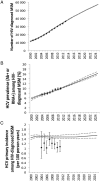Can Hepatitis C Virus (HCV) Direct-Acting Antiviral Treatment as Prevention Reverse the HCV Epidemic Among Men Who Have Sex With Men in the United Kingdom? Epidemiological and Modeling Insights
- PMID: 26908813
- PMCID: PMC4826456
- DOI: 10.1093/cid/ciw075
Can Hepatitis C Virus (HCV) Direct-Acting Antiviral Treatment as Prevention Reverse the HCV Epidemic Among Men Who Have Sex With Men in the United Kingdom? Epidemiological and Modeling Insights
Abstract
Background: We report on the hepatitis C virus (HCV) epidemic among human immunodeficiency virus (HIV)-positive men who have sex with men (MSM) in the United Kingdom and model its trajectory with or without scaled-up HCV direct-acting antivirals (DAAs).
Methods: A dynamic HCV transmission model among HIV-diagnosed MSM in the United Kingdom was calibrated to HCV prevalence (antibody [Ab] or RNA positive), incidence, and treatment from 2004 to 2011 among HIV-diagnosed MSM in the UK Collaborative HIV Cohort (UK CHIC). The epidemic was projected with current or scaled-up HCV treatment, with or without a 20% behavioral risk reduction.
Results: HCV prevalence among HIV-positive MSM in UK CHIC increased from 7.3% in 2004 to 9.9% in 2011, whereas primary incidence was flat (1.02-1.38 per 100 person-years). Over the next decade, modeling suggests 94% of infections are attributable to high-risk individuals, comprising 7% of the population. Without treatment, HCV chronic prevalence could have been 38% higher in 2015 (11.9% vs 8.6%). With current treatment and sustained virological response rates (status quo), chronic prevalence is likely to increase to 11% by 2025, but stabilize with DAA introduction in 2015. With DAA scale-up to 80% within 1 year of diagnosis (regardless of disease stage), and 20% per year thereafter, chronic prevalence could decline by 71% (to 3.2%) compared to status quo in 2025. With additional behavioral interventions, chronic prevalence could decline further to <2.5% by 2025.
Conclusions: Epidemiological data and modeling suggest a continuing HCV epidemic among HIV-diagnosed MSM in the United Kingdom driven by high-risk individuals, despite high treatment rates. Substantial reductions in HCV transmission could be achieved through scale-up of DAAs and moderately effective behavioral interventions.
Keywords: HIV; antiviral treatment; hepatitis C virus; men who have sex with men; prevention.
© The Author 2016. Published by Oxford University Press for the Infectious Diseases Society of America.
Figures




References
-
- Urbanus AT, van de Laar TJ, Stolte IG et al. . Hepatitis C virus infections among HIV-infected men who have sex with men: an expanding epidemic. AIDS 2009; 23:F1–7. - PubMed
-
- Yaphe S, Bozinoff N, Kyle R, Shivkumar S, Pai N, Klein M. Incidence of acute hepatitis C virus infection among men who have sex with men with and without HIV infection: a systematic review. Sex Trans Infect 2012; 88:558–64. - PubMed
-
- Giraudon I, Ruf M, Maguire H et al. . Increase in diagnosed newly acquired hepatitis C in HIV-positive men who have sex with men across London and Brighton, 2002–2006: is this an outbreak? Sex Transm Infect 2008; 84:111–6. - PubMed
Publication types
MeSH terms
Substances
Grants and funding
- PDF-2011-04-049/DH_/Department of Health/United Kingdom
- G0801822/MRC_/Medical Research Council/United Kingdom
- R01 DA037773-01A1/DA/NIDA NIH HHS/United States
- MR/K023233/1/MRC_/Medical Research Council/United Kingdom
- G0701627/MRC_/Medical Research Council/United Kingdom
- RP-DG-0610-10055/DH_/Department of Health/United Kingdom
- P30 AI036214/AI/NIAID NIH HHS/United States
- WT_/Wellcome Trust/United Kingdom
- WT 102789/WT_/Wellcome Trust/United Kingdom
- R01 DA037773/DA/NIDA NIH HHS/United States
- MC_UU_12014/1/MRC_/Medical Research Council/United Kingdom
- MR/M004236/1/MRC_/Medical Research Council/United Kingdom
LinkOut - more resources
Full Text Sources
Other Literature Sources
Medical

